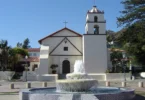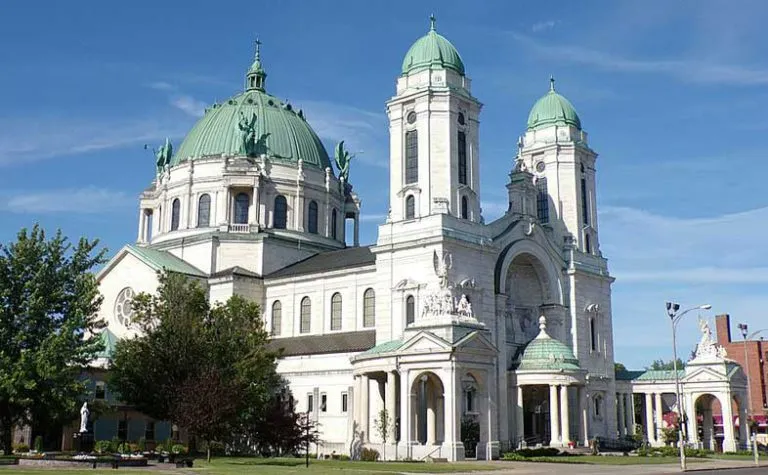
Introduction
The Our Lady of Victory Basilica is a Catholic parish church and national shrine in Lackawanna, New York. Due to the multiple charities of founder Father Nelson Baker, the shrine is a popular pilgrimage and visitor destination in Lackawanna. It is part of the Diocese of Buffalo.
One of Western New York’s most exquisite landmarks, Our Lady of Victory National Shrine and Basilica attracts visitors worldwide. Rivalling the great churches of Europe, the Basilica was built in 1926 as a gift of thanks to the Blessed Mother from Venerable Nelson Baker, a current candidate for sainthood whose final resting place is located within the church. Prominent features of the shrine include breath-taking painting and marble sculpture, as well as the Father Baker Museum and OLV Gift Shop located in the lower level.
History of Our Lady of Victory Basilica, Lackawanna
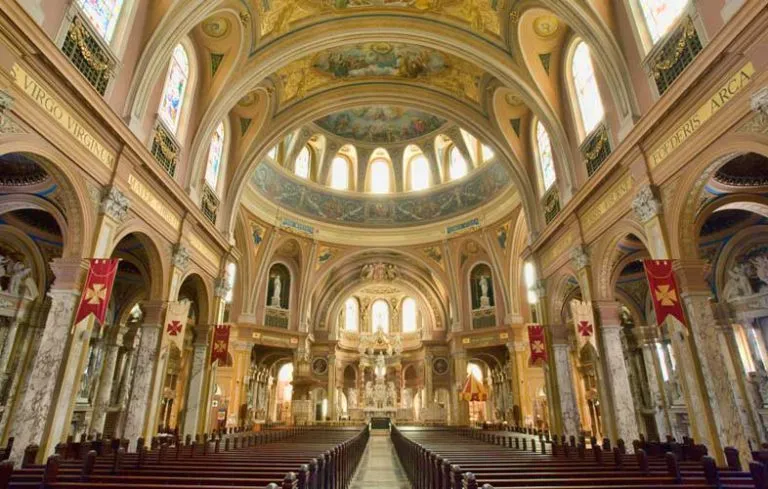
In 1916, fire seriously damaged St. Patrick’s Parish Church in Lackawanna, New York. Repairs were made, but Father Baker, superintendent priest of the busy parish developed plans to replace the church. On May 7, 1921, Father Baker celebrated the last Mass at St. Patrick’s.
The structure was immediately dismantled to make way for something larger. Construction on the basilica began in 1921 after Father Baker unveiled plans at a parish council meeting to build a shrine in homage to the Blessed Mother. Because of Baker’s influence in the community and well-known charitable reputation across the nation, he was able to get sufficient financial support to begin construction quickly.
Baker solicited support for his project, and thousands from across the nation contributed funding both large and small, mostly through a direct-mail fundraising club. Designed by Emile Ulrich, the basilica was constructed at a cost of $3.2 million, but the project was completed without the parish incurring any debt.
By late 1925, construction on the sanctuary of Our Lady of Victory was complete, and the first Mass was held there on Christmas of that year. On May 25, 1926, a consecration ceremony took place presided over by Father Baker, Bishop William Turner of the Diocese of Buffalo, and Cardinal Patrick Hayes. Thousands of priests, religious sisters, and believers from across the nation attended the event. Two months later, Pope Pius XI designated the shrine with the honorable title of “Minor Basilica” via an apostolic decree. Baker was in charge of the basilica and the parish’s various institutions of charity, until his death on July 29, 1936.
The basilica has had only two significant changes to its original design. The first came in 1941 during a violent lightning storm that caused significant damage to the basilica’s twin towers (a style associated with Portuguese churches).
Baker’s first successor, Monsignor Joseph Maguire, took charge of the efforts to refurbish the structures. He had the marble towers replaced with the lower, enclosed, copper dome-tipped towers that still top the basilica today. Following the harsh winter of 2001–2002, the roof of the National Shrine was found to have significantly deteriorated. Its copper had turned a greenish hue due to overexposure to the elements (a similar chemical effect as seen on the Statue of Liberty) and was no longer weather tight. A new copper roof was installed.
In 2001, a celebration of the National Shrine’s Diamond Jubilee and basilica’s 75 years in the making was held at the Our Lady of Victory Parish. On May 26, a special Mass was followed by a dinner party, at which hundreds of dignitaries, clergy members, and friends came together to celebrate the basilica and Father Baker’s legacy.
Relics of Father Baker
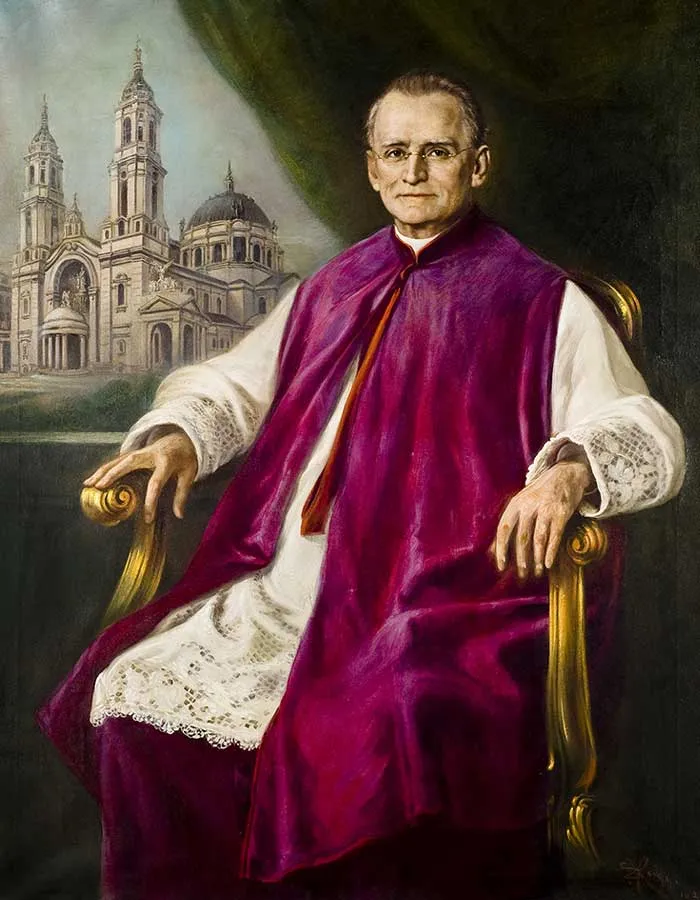
In July 1998, through the efforts of Bishop Henry J. Mansell, it was announced that the remains of Father Baker would be relocated from nearby Holy Cross Cemetery and reinterred in the basilica. The move was ordered by the Congregation for the Causes of Saints in Rome, to signify a step toward declaring Baker a saint.
On March 11, 1999, Father Baker’s casket was carried by six men who were raised by Baker, and placed in a sarcophagus within the Grotto Shrine to Our Lady of Lourdes, found on the southern end of the basilica’s transept. It is estimated that nearly 6,000 people attended the event at the basilica that day to honor Baker and his work. The re-interment helped raise awareness of Baker, his mission, and his legacy across the world. On January 14, 2011, Pope Benedict XVI declared Fr. Baker “venerable”.
Our Lady of Victory
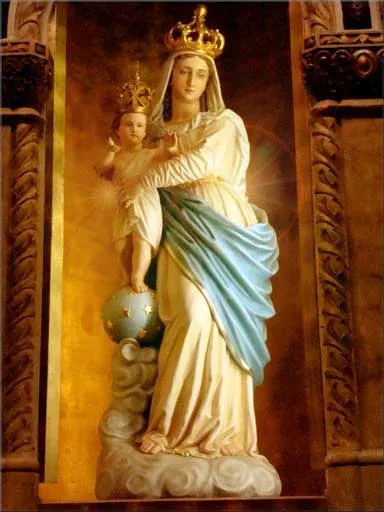
During the pontificate of Pope Pius V, 1566-72, the Ottoman Turks became a serious threat to Christian nations. They controlled maritime power in the Mediterrranean, and regularly raided the coast cities of Italy. Venice, the most vulnerable, tried to maintain a strategic neutrality to protect her trade with the East. When Sultan Selim II demanded the surrender of Cyprus, the Venetians appealed to the Pope.
Pius V proposed the Holy League of Christian powers, the crusade against the Turks. He succeeded in organizing a fleet at Messina under command of Don Juan of Austria. In 1571 this fleet comprised 206 galley ships and 80.000 soldiers from Venice, Naples, Genoa, Spain and Malta. The Turks had superior forces – 230 galleys and 120,000 soldiers.
Don Juan aboard the flagship, Reale, sailed down the Greek coast on the morning of October 7th 1571 and spied the Turkish fleet in the Gulf of Lepanto (Corinth). Admiral Ali Pasha aboard his flagship, Sultana, took the lead. Christian and Turkish fleets engaged in battle. By day’s end the Sultana was captured, Ali Pasha was slain, the Turks were routed, and 12,000 Christians were released from slavery.
On the very same day, October 7th, the Rosary Confraternity of Rome met in the Dominican Church to pray for the victory of the Christian forces. When the news of victory did reach Rome, it was attributed to the intercession of Our Lady. In commemoration of Lepanto, Pope Pius V established a feast in honor of Our Lady of Victory. Later Gregory XIII changed it to the feast of the Most Holy Rosary, celebrated on October 7th.
Architecture - Exterior
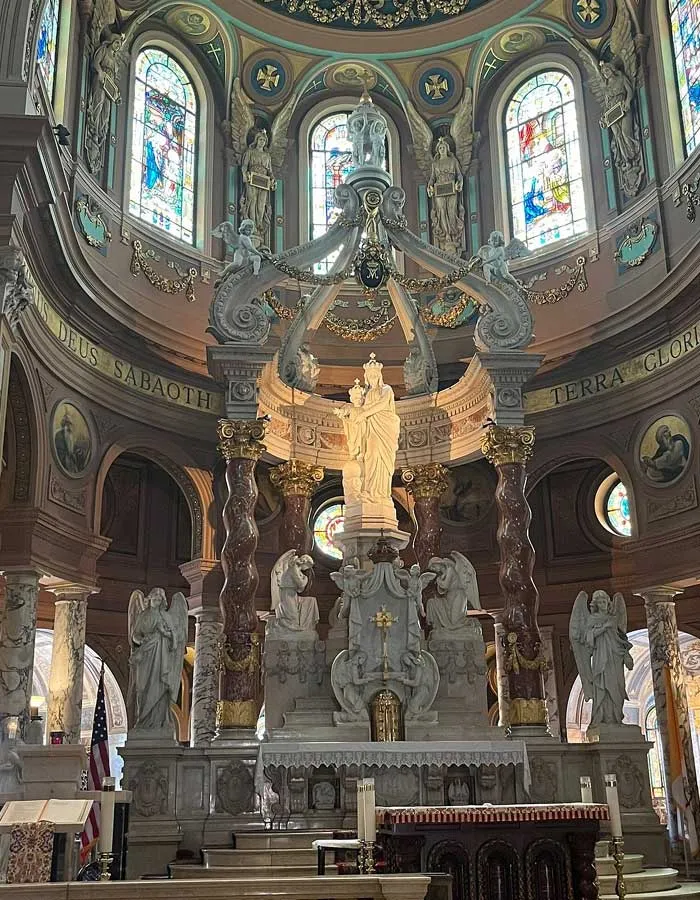
The design of the exterior of the basilica was the work of French ecclesiastical architect Emile Ulrich. To fulfill Father Baker’s wish for the finest materials and workmanship, Ulrich halted all other projects from his architectural firm in Cleveland and spent his time personally inspecting artists’ work both in the United States and Europe.
The majority of the exterior of the shrine is constructed almost entirely of pure white marble, supplied by the Georgia Marble Company of Tate, Georgia. Throughout the basilica’s interior and parts of the exterior, a combination of more than 40 different types, colors, and designs of Italian marble can also be found.
Great Dome
A prominent feature of the basilica’s exterior is the large copper dome. The dome, measuring 165 feet in height, was second in size only to the U.S. Capitol building in Washington, D.C. at the time of its completion in 1926. Over the years, the dome’s original copper has aged to a green patina, as expected. Four copper angel statues playing trumpets, measuring 18 feet tall, are mounted on the dome.
Twin Towers
The original twin towers of the basilica, when completed in 1926, stood at a height of 165 feet (about 16 stories). The spires were made completely of marble and had an open design. In 1941, a violent lightning storm caused major damage to both the towers, forcing redesign and refurbishing. The new towers, enclosed and much shorter than the originals, are topped with copper domes, similar to the design of the basilica’s Great Dome.
Main Entrance
Two large colonnades extend outward and flank the exterior sides of the shrine at the main entrance. On top of each is a marble sculpture of a group of children overseen by a large angel. On the left colonnade (when facing the basilica’s front), the children are led by a religious sister.
This figure represents the Sisters of St. Joseph, the order which has staffed the Our Lady of Victory Institutions since 1856. On the right colonnade, the children are led by a priest, Father Baker. This figure of Baker was ordered by Ulrich to honor the priest for his several contributions to the Our Lady of Victory Institutions. Also at the entrance to the basilica is a domed niche that houses a 12-foot-tall, 16,000-pound (eight tons) statue of Our Lady of Victory, crafted of the finest Carrara marble available.
Interior - The Great Dome and Ceiling
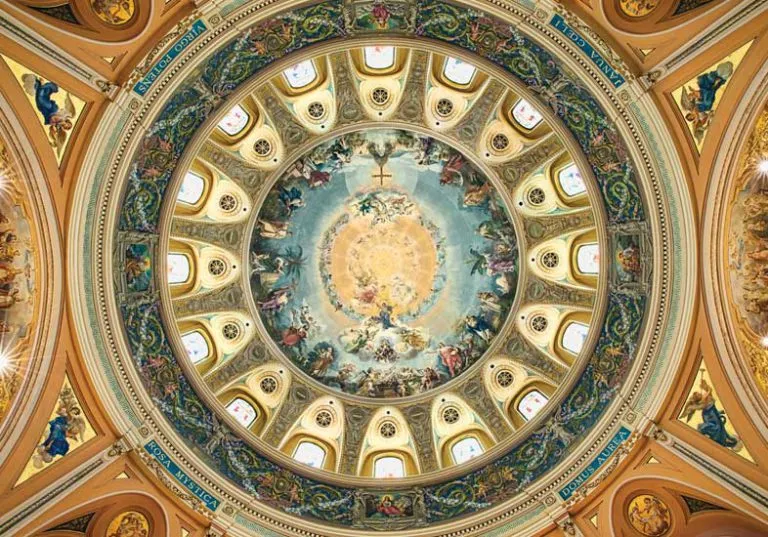
The largest work of art is the decoration of the Great Dome, 80 feet (24 m) in diameter, which depicts the Assumption of Mary and the Blessed Mother’s Coronation. Around the dome’s outer edge, the 12 apostles and three archangels are shown, while an angelic host carries Mary towards heaven. Slightly higher within the dome, Jesus in red robes can be seen awaiting her. At the pinnacle of the dome, 120 feet (37 m) above the basilica floor, a white Dove of Peace looks down from Heaven at the basilica.
From the Great Dome to the choir loft, the ceiling is covered by five giant murals. They depict Mary as Queen of Patriarchs, Queen of the Apostles, Queen of the Angels, Queen of the Prophets, and Queen of the Martyrs. The two walls on the basilica’s sides feature huge paintings depicting scenes from the Gospels: the Massacre of the Innocents, the Flight into Egypt, and the Birth of Jesus at Bethlehem.
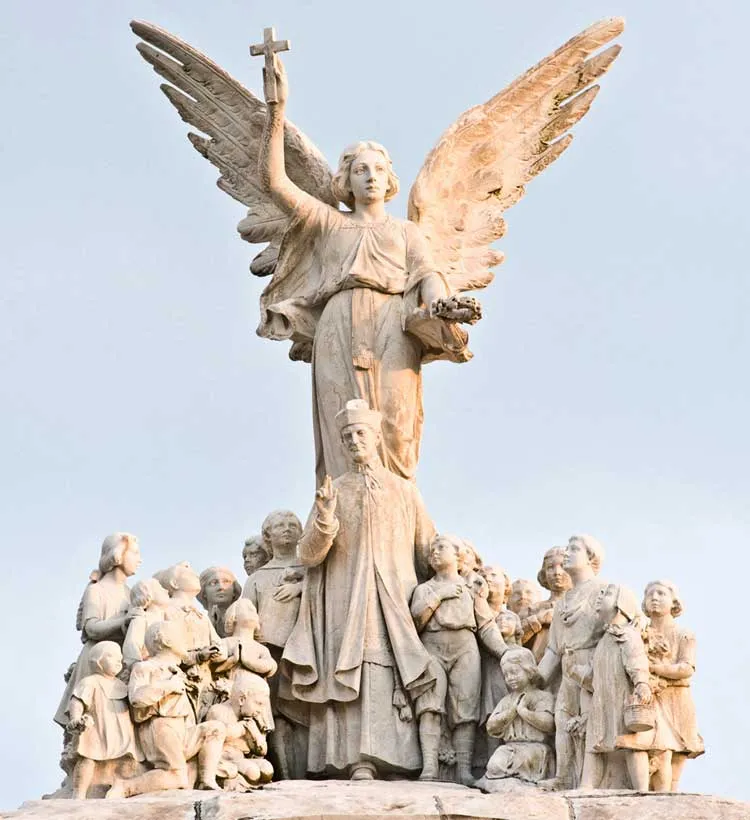
The Main Altar
The main altar features a 9 feet (2.7 m) tall, 1,600 pounds (730 kg) statue of Our Lady of Victory. This was blessed by Pope Pius XI after being sculpted in Italy. Baker placed a painting of the pope on the altar in return.
Flanking the altar are four, swirled marble columns of rare red marble, reminiscent of St. Peter’s Basilica in Rome. A legend told about the marble says a group of Buffalo-born soldiers stumbled upon the unique red marble while in Spain during World War I. Upon seeing it, the soldiers thought immediately of the basilica being built at home by Father Baker.
They went to talk to the Spanish farmer who owned the property. After hearing the story of Father Baker, the farmer agreed to donate the “useless rock” on his property. Arrangements were made and the marble was sent to Lackawanna to complete the work on the basilica’s altar.
The main altar stands under a bright blue dome depicting the Holy Spirit in brilliant hues. On the ceiling over the altar, an elongated panel represents “Queen of All Saints”. Among the saints are Mary Magdalene, St. Anthony, St. Elizabeth, St. Anne, and St. Theresa.
Items of Papal Significance
Near the altar, at one end of the pews, stands the umbraculum, a symbolic canopy or umbrella which is kept half open until the Pope visits the basilica and completely opens it. The tintinnabulum, a small gold bell mounted on a pole with a golden frame, stands at the other end. It is used to lead the procession when the Pope says Mass within the basilica. These two items, along with the personal coat of arms of a pope, which hangs above the bronze main entrance doors, signify the shrine’s Basilica status within the Catholic community.
Stations of the Cross
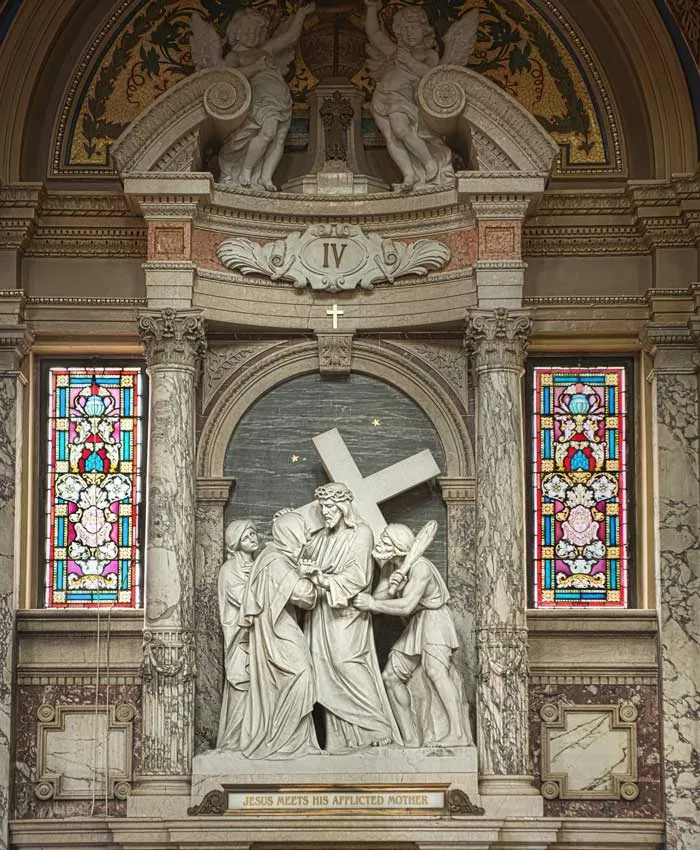
The shrine is flanked by the 14 marble Stations of the Cross, which depict Jesus’ final hours before his death. Rather than the elements being carved from separate blocks of marble and assembled for each Station afterwards, each Station was sculpted from single blocks. The figures are depicted at life size. The Italian sculptor Pepini spent 14 years on the design and execution.
The station entitled “Jesus Meets His Afflicted Mother” was one of Father Baker’s favorite places in the basilica. In his 80s by the time the basilica was completed, Baker could be often found leaning on the pillar closest to this Station, meditating and saying prayers.
The Organ
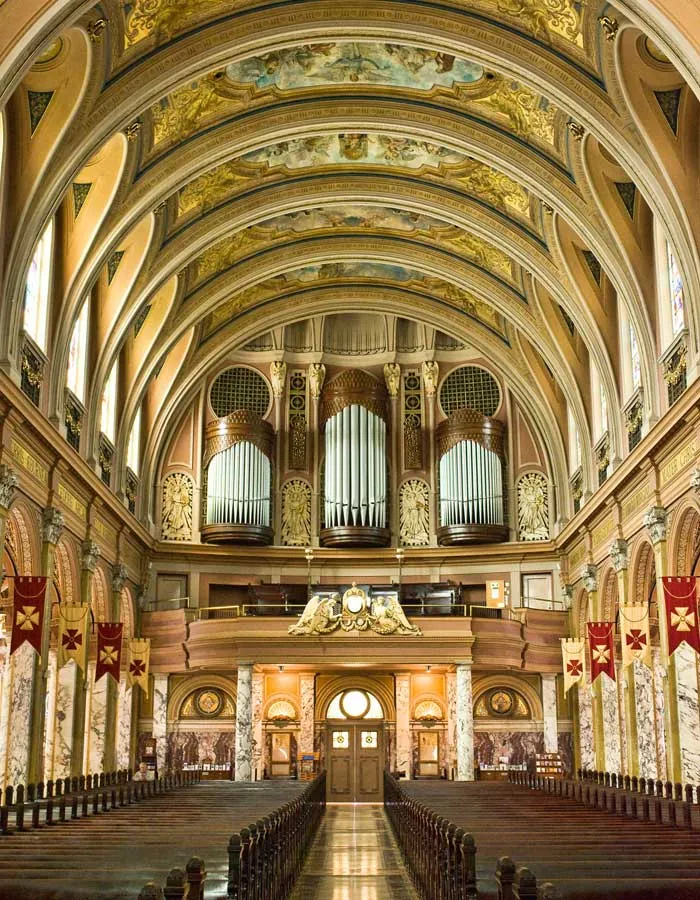
When the original, custom-made Wurlitzer organ installed in the choir loft had deteriorated beyond repair, a specially-designed 54-rank pipe organ was installed in its place. Built by the Delaware Pipe Organ Co. and installed in 1981, the organ has three mahogany pipe towers, each in an eight-foot semicircle, representing the Holy Trinity.
There are 51 pipes in the three towers, with the balance of pipes located behind the towers. The pipework is of metal and wood, and ranges in length from six inches to 18 feet.
The Grotto and Father Baker's Remains
Baker’s remains are in a sarcophagus within the Grotto Shrine to Our Lady of Lourdes, found on the southern end of the basilica’s transept. The Grotto is hewn out of black lava rock from Mount Vesuvius in Italy. Baker, who had died in 1936, had wanted to find a construction material that was “untouched by humans” to commemorate the vision of the Blessed Mother to St. Bernadette in Lourdes, France.
Other Sculptures and Artwork
The interior is decorated with several religious paintings, sculptures, and mosaics depicting devotion to the Blessed Mother. It is estimated that from 1,500 to 2,500 angels can be found in the basilica in the sculptures and artwork. It was Baker’s plan to place an angel in every possible sightline, to remind visitors that although the basilica is dedicated to Our Lady of Victory, its main purpose is meant primarily for God’s praise and glory.
Pews and Aisle
The basilica’s pews are made of rare African mahogany, and provide seating for more than 1,200 individuals. The shrine’s floor and aisle are gradually sloped to ensure that all have an unobstructed view of the basilica’s main altar.
Altars
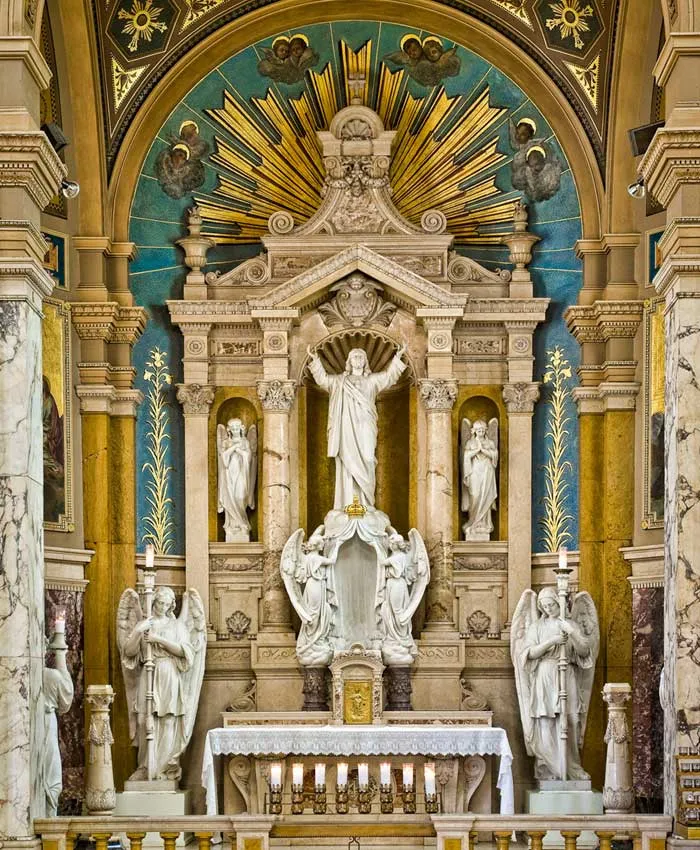
Consistent with the architectural styles of many churches, the Basilica features a number of other altars along its perimeter. Behind the main altar, a total of seven smaller altars can be found.
One is dedicated to St. Patrick, commemorating the original church at the site. Another, donated by some of the “Baker Boys” – children raised within Father Baker’s vast “City of Charity” – honors St. Vincent de Paul, whose work with the poor and downtrodden served as a model for Father Baker himself. The five remaining altars are dedicated to Mary Immaculate, St. Aloysius, St. Anne, St. Anthony, and St. Therese.
Three additional major altars are located in the nave. Along the east wall is the altar in honor of the Sacred Heart of Jesus. Adjacent to this altar is the Grotto Shrine of Our Lady of Lourdes, now home to the tomb of Father Baker.
Located on the west wall is an altar dedicated to St. Joseph, depicted holding the hand of the Christ Child. Murals surrounding the altar tell the story of Joseph’s life, depicting his carpentry shop, the dream of the angel, the espousal to the Blessed Mother, and his death.
Baptistery
Located adjacent to the main altar, the bapistery features a marble baptismal font, as well as dozens of wall and ceiling paintings with religious symbols and peoples.
Father Baker Museum
During late 2009, construction began to create a small museum about Father Baker’s life and the history of the Our Lady of Victory Institutions. It is located in the basilica’s basement, where the chapel and Father Baker Rooms were formerly located. A number of photos, official documents, vintage newspapers, and Baker’s belongings are on display.
Items such as Father Baker’s desk, books, clothing, and furniture can be found throughout the museum. Also in the museum are cases of photos, information, and memorabilia from the Our Lady of Victory Institutions, such as the Infant Home, Orphanage, Protectory, and the basilica itself. On that floor of the basilica is the remodelled gift shop offering religious items such as rosaries, and related goods.
Father Baker's Tomb
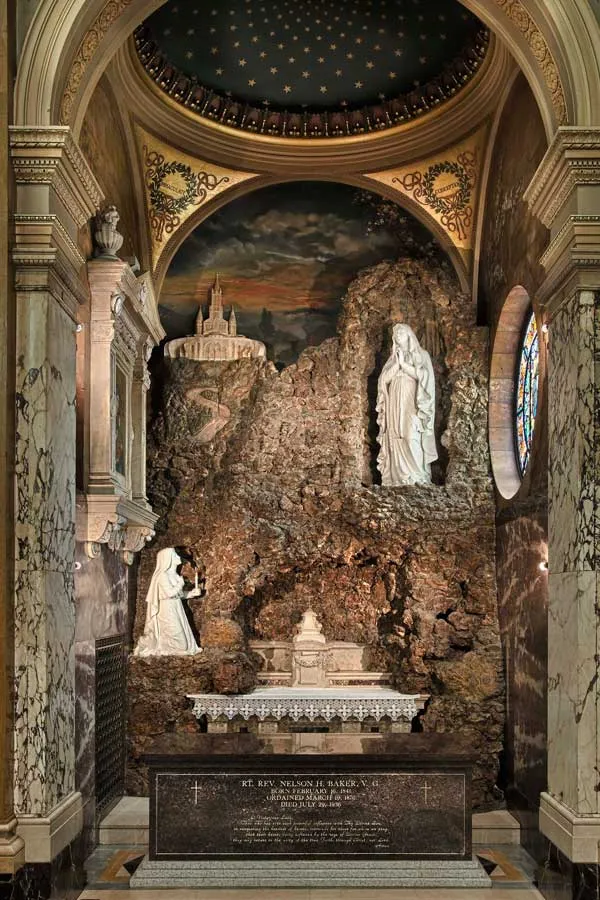
March 11, 1999, was a date which would see a profound change in the Basilica, and in the minds of thousands of Western New Yorkers. For it was on that day that Father Nelson Baker “came home.”
In July of 1998, then-pastor Msgr. Robert Wurtz announced that the earthly remains of Father Baker would be transferred from nearby Holy Cross Cemetery into the Basilica. The move, which was recommended by the Congregation for the Causes of Saints in Rome, would help raise awareness of the humble priest, his mission and his legacy.
On that sunny March morning, Father Baker’s casket was carried into the Basilica and placed in a tomb within the Grotto Shrine to Our Lady of Lourdes. A truly unique area, the Grotto is hewn out of lava rock from Mount Vesuvius in Italy. At the time of its construction, Father Baker insisted on finding a material that was untouched by human hands to pay tribute to the vision of Our Blessed Lady to St. Bernadette in Lourdes, France.
Stained Glass
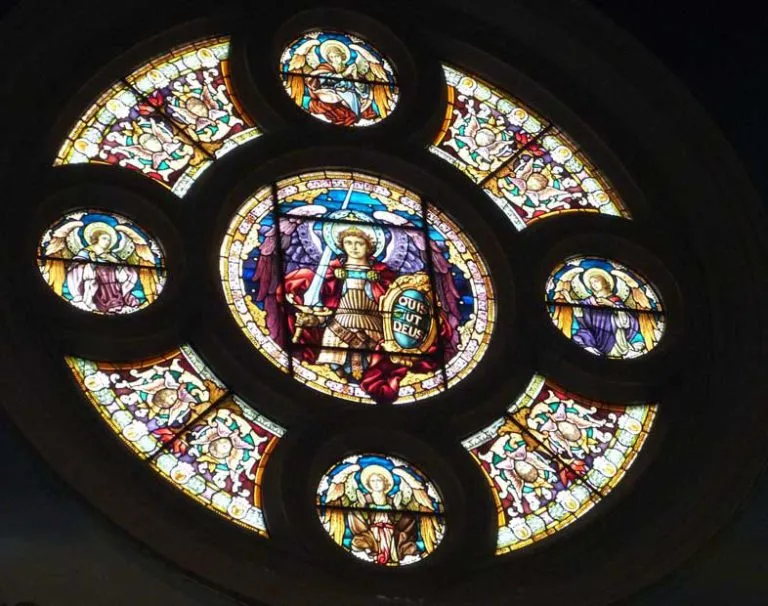
Exquisitely detailed stained glass windows complement and enhance the marble and painted work inside the Basilica. The hundreds of intricately designed panels tell stories and illustrate characters and themes of holy significance to complete Father Baker’s vision by casting an intimate glow over every corner of the Shrine.
Feast Day - 7th October
The Feast of Our Lady of the Rosary, formerly known as Feast of Our Lady of Victory and Feast of the Holy Rosary is celebrated on 7 October in the General Roman Calendar. 7 October is the anniversary of the decisive victory of the combined fleet of the Holy League of 1571 over the Ottoman navy at the Battle of Lepanto.
Mass Time
Weekdays
Saturdays
Sundays
Church Visiting Time
Contact Info
767 Ridge Road, Luckawanna,
New York, NY 14218, United States.
Phone No.
Tel : +1 716-828-9444
Accommodations
How to reach the Basilica
Buffalo Niagara International Airport in Cheektowaga, New York, United States is the nearby Airport to the Basilica.
Special Events Light Rail Station in Buffalo, New York, United States is the nearby Train Station to the Basilica.






